Technology

I don&t want to hurt your feelings, but herethe truth: Not all readers are created equal.
At least, thathow things look from a user acquisition perspective, where publishers running ad campaigns to reach new readers might end up bringing in a whole bunch of random visitors who are unlikely to ever return their site again.
&Itless about just getting eyeballs on the content,& said Jared Lansky, chief commercial officer at marketing startup Keywee. &Loyalty is just more valuable for publishers.&
Keywee (backed by Eric SchmidtInnovation Endeavors and The New York Times) is trying to solve this problem with a new feature called the Loyalty Score. Lansky told me that the score does exactly what the name suggests — it measures reader loyalty, based on how many times someone returns to the site and how many pages they view.
This, in turn, can help publishers make smarter decisions about growth. They can see which of the Facebook ad campaigns run through Keywee are actually bringing in loyal readers and which aren&t. And they can tweak the campaigns accordingly, targeting audiences and highlighting articles in a way thatmost likely to attract loyal readers rather than random visitors.
The score can also shape the way that publishers interact with visitors on their own site. For example, if they&re trying to build a subscription business, they can target their subscription offers and paywalls at readers with a higher Loyalty Score.
Lansky also noted that the data used to calculate the score comes from the Keywee pixel and the Facebook pixel, with no additional data collection required.
&Loyalty Score has given us a whole new world of insights into our user acquisition campaigns,& said Kiplinger.com Director of Digital Operations - Advertising Andy Price in a statement. &For example, we&re seeing that promoting content that talks about planning for retirement drives more return visitors than posts about saving money on groceries.&
- Details
- Category: Technology
Read more: Keywee introduces a new Loyalty Score to help publishers reach the most valuable readers
Write comment (93 Comments)Software will eat the world, as the saying goes, but in doing so, some developers are likely to get a little indigestion. That is to say, building products requires working with disparate and distributed teams, and while developers may have an ever-growing array of algorithms, APIs and technology at their disposal to do this, ironically the platforms to track it all haven&t evolved with the times. Now three developers have taken their own experience of that disconnect to create a new kind of platform, Linear, which they believe addresses the needs of software developers better by being faster and more intuitive. Itbug tracking you actually want to use.
Today, Linear is announcing a seed round of $4.2 million led by Sequoia, with participation also from Index Ventures and a number of investors, startup founders and others that will also advise Linear as it grows. They includeDylan Field (Founder and CEO, Figma), Emily Choi (COO, Coinbase), Charlie Cheever (Co-Founder of Expo - Quora), Gustaf Alströmer (Partner, Y Combinator), Tikhon Berstram (Co-Founder, Parse), Larry Gadea (CEO, Envoy), Jude Gomila (CEO, Golden), James Smith (CEO, Bugsnag), Fred Stevens-Smith (CEO, Rainforest), Bobby Goodlatte, Marc McGabe, Julia DeWahl and others.
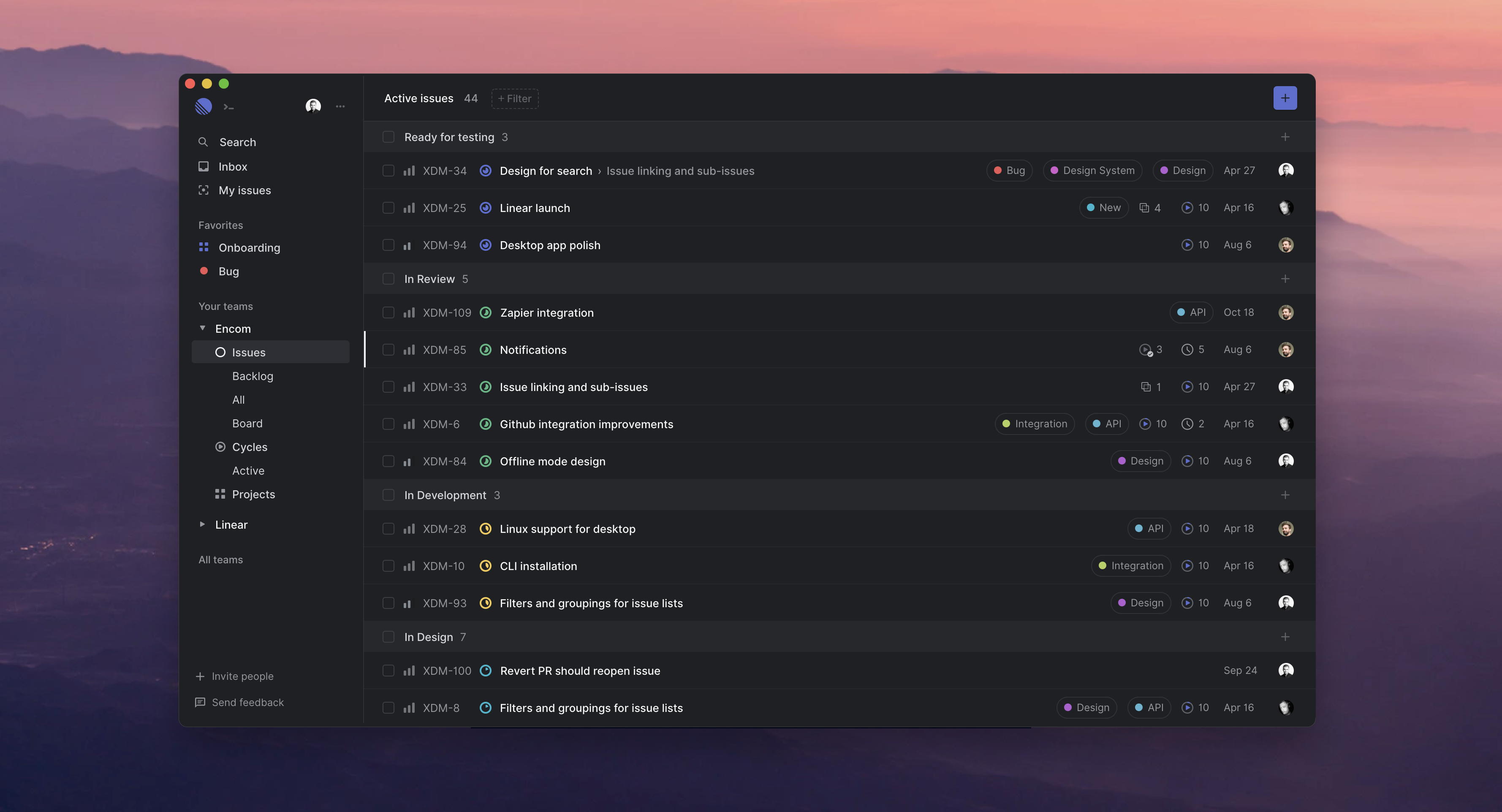
Cofounders Karri Saarinen, Tuomas Artman, and Jori Lallo — all Finnish but now based in the Bay Area — know something first-hand about software development and the trials and tribulations of working with disparate and distributed teams. Saarinen was previously the principal designer of Airbnb, as well as the first designer of Coinbase; Artman had been staff engineer and architect at Uber; and Lallo also had been at Coinbase as a senior engineer building its API and front end.
&When we worked at many startups and growth companies we felt that the tools weren&t matching the way we&re thinking or operating,& Saarinen said in an email interview. &It also seemed that no-one had took a fresh look at this as a design problem. We believe there is a much better, modern workflow waiting to be discovered. We believe creators should focus on the work they create, not tracking or reporting what they are doing. Managers should spend their time prioritizing and giving direction, not bugging their teams for updates. Running the process shouldn&t sap your teamenergy and come in the way of creating.&

Linear cofounders (from left): KarriSaarinen, Jori Lallo, and Tuomas Artma
All of that translates to, first and foremost, speed and a platform whose main purpose is to help you work faster. &While some say speed is not really a feature, we believe itthe core foundation for tools you use daily,& Saarinen noted.
A ⌘K command calls up a menu of shortcuts to edit an issuestatus, assign a task, and more so that everything can be handled with keyboard shortcuts. Pages load quickly and synchronise in real time (and search updates alongside that). Users can work offline if they need to. And of course there is also a dark mode for night owls.
The platform is still very much in its early stages. It currently has three integrations based on some of the most common tools used by developers — GitHub (where you can link Pull Requests and close Linear issues on merge), Figma designs (where you can get image previews and embeds of Figma designs), and Slack (you can create issues from Slack and then get notifications on updates). There are plans to add more over time.
&We started solving the problem from the end-user perspective, the contributor, like an engineer or a designer and starting to address things that are important for them, can help them and their teams,& Saarinen said. &We aim to also bring clarity for the teams by making the concepts simple, clear but powerful. For example, instead of talking about epics, we have Projects that help track larger feature work or tracks of work.&

Indeed, speed is not the only aim with Linear. Saarinen also said another area they hope to address is general work practices, with a take that seems to echo a turn away from time spent on manual management and more focus on automating that process.
&Right now at many companies you have to manually move things around, schedule sprints, and all kinds of other minor things,& he said. &We think that next generation tools should have built in automated workflows that help teams and companies operate much more effectively. Teams shouldn&t spend a third or more of their time a week just for running the process.&
The last objective Linear is hoping to tackle is one that we&re often sorely lacking in the wider world, too: context.
&Companies are setting their high-level goals, roadmaps and teams work on projects,& he said. &Often leadership doesn&t have good visibility into what is actually happening and how projects are tracking. Teams and contributors don&t always have the context or understanding of why they are working on the things, since you cannot follow the chain from your task to the company goal. We think that there are ways to build Linear to be a real-time picture of what is happening in the company when it comes to building products, and give the necessary context to everyone.&
Linear is a late entrant in a world filled with collaboration apps, and specifically workflow and collaboration apps targeting the developer community. These include not just Slack and GitHub, but AtlassianTrello and Jira, as well as Asana, Basecamp and many more.
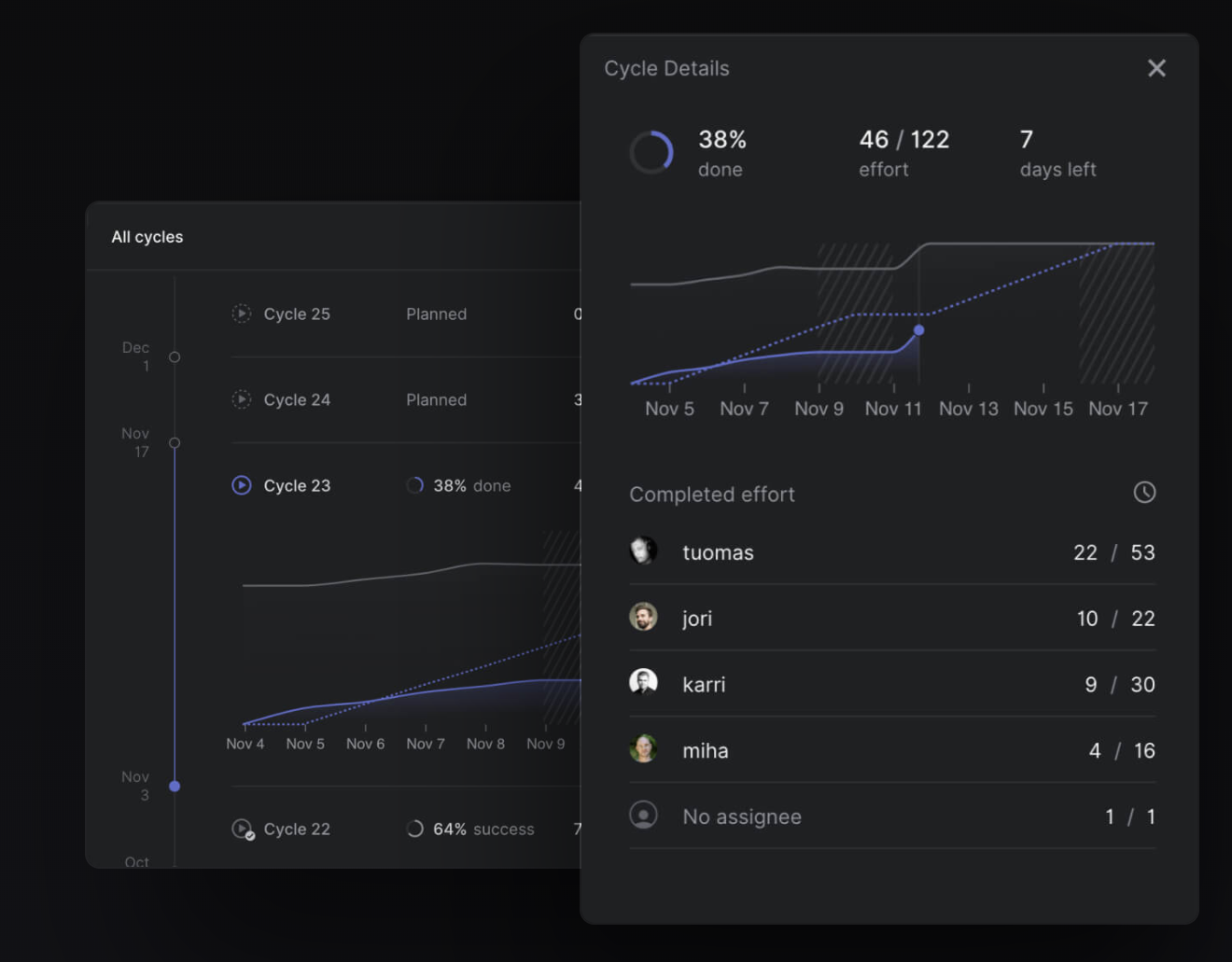
Saarinen would not be drawn out on which of these (or others) that it sees as direct competition, noting that none are addressing developer issues of speed, ease of use and context as well as Linear is.
&There are many tools in the market and many companies are talking about making ‘work better,'& he said. &And while there are many issue tracking and project management tools, they are not supporting the workflow of the individual and team. A lot of the value these tools sell is around tracking work that happens, not actually helping people to be more effective. Since our focus is on the individual contributor and intelligent integration with their workflow, we can support them better and as a side effect makes the information in the system more up to date.&
Stephanie Zhan, the partner at Sequoia whose speciality is seed and Series A investments and who has led this round, said that Linear first came on her radar when it first launched its private beta (itstill in private beta and has been running a waitlist to bring on new users. In that time itpicked up hundreds of companies, including Pitch, Render, Albert, Curology, Spoke, Compound and YC startups including Middesk, Catch and Visly). The company had also been flagged by one of SequoiaScouts, who invested earlier this year

Although Linear is based out of San Francisco, itinteresting that the three founders& roots are in Finland (with Saarinen in Helsinki this week to speak at the Slush event), and brings up an emerging trend of Silicon Valley VCs looking at founders from further afield than just their own back yard.
&The interesting thing about Linear is that as they&re building a software company around the future of work, they&re also building a remote and distributed team themselves,& Zahn said. The company currently has only four employees.
In that vein, we (and others, it seems) had heard that Sequoia — which today invests in several Europe-based startups, including Tessian, Graphcore, Klarna, Tourlane, Evervault and CEGX — has been considering establishing a more permanent presence in this part of the world, specifically in London.
Sources familiar with the firm, however, tell us that while it has been sounding out VCs at other firms, saying a London office is on the horizon might be premature, as there are as yet no plans to set up shop here. However, with more companies and European founders entering its portfolio, and as more conversations with VCs turn into decisions to make the leap to help Sequoia source more startups, we could see this strategy turning around quickly.
- Details
- Category: Technology
Read more: Linear takes $4.2M led by Sequoia to build a better bug tracker and more
Write comment (95 Comments)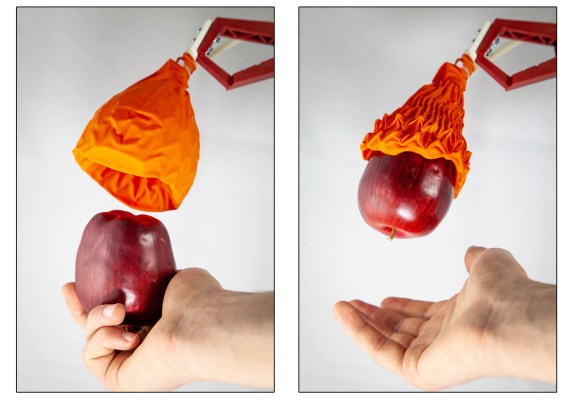
MIT researchers have developed a new way to optimize how soft robots perform specific tasks — a huge challenge when it comes to soft robotics in particular, because robots with flexible bodies can basically move in an infinite number of ways at any given moment, so programming them to do something in the best way possible is a monumental task.
To make the whole process easier and less computationally intensive, the research team has developed a way to take what is effectively a robot that can move in infinite possible dimensions and simplify it to a representative &low-dimensional& model that can accurately be used to optimize movement, based on environmental physics and the natural ways that soft objects shaped like any individual soft robot is actually most likely to bend in a giving setting.
So far, the MIT team behind this has demonstrated it in simulation only, but in this simulated environment it has seen significant improvements in terms of both speed and accuracy of programmed movement of robots versus methods used today that are more complex. In fact, across a number of tests of simulated robots with both 2D and 3D designs, and two and four-legged physical designs, the researchers were able to show that optimizations that would normally task as many as 30,000 simulations to achieve were instead possible in just 400.
Why is any of this even important? Because it basically shrinks drastically the amount of computational overhead required to get good movement results out of soft robots, which is a key ingredient in helping make them partial to actually use in real-life applications. If programming a soft robot to do something genuinely useful like navigate and effect an underwater damage assessment and repair requires huge amounts of processing power, and significant actual time, itnot really viable for anyone to actually deploy.
In the future, the research team hopes to bring their optimization method out of simulation and into real-world testing, as well as full-scale development of soft robots from start to finish.
- Details
- Category: Technology
Read more: MIT researchers develop a much better way to optimize the control of soft robots
Write comment (95 Comments)Welcome to this edition of The Operators, a recurring Extra Crunch column, podcast, and YouTube show that brings you insights and information from inside top tech companies. Our guests are execs with operational experience at fast-rising startups, like Brex, Calm, DocSend, and Zeus Living, and more established companies, like AirBnB, Facebook, Google, and Uber. Here, they share strategies and tactics for building your first company and charting your career in tech.
In this episode, we&re talking about growth. Growth means different things inside different organizations, but correctly identifying avenues for sustainable and scalable growth is a priority for almost all companies. We&ll cover:
- Defining growth and being good at it
- Managing growth without losing sight of the big picture
- How companies should approach growth
To learn more, we spoke with two experts:
Isaac Silverman began his career as an entrepreneur before joining Zynga to work on growth development. At Zynga, he focused on some of the most cutting-edge approaches to growth and development. He then moved to Postmates, where he focused on growth product and is now the head of rider growth at Uber.
Matias Honorato is a senior manager on the growth team at Tally, a growth-stage tech company, and also brings his own entrepreneurial roots and experience at companies like Earnest and Tradecraft.
Below is a summary of our conversation; check out The Operators for the full episode.
Defining growth and being good at it
Growth as a concept and discipline originates from the term &growth hacking.& It can be hard to grasp as distinct from functions and goals that usually sit with the marketing team or product development team and may be best thought of as a combination of both. We think of it as the domain responsible for designing, implementing, and measuring approaches to acquiring and retaining customers. Ita mix of marketing and product, but also sales and data analytics, and sometimes even operations.
Great growth professionals can be successful with a wide variety of work or educational backgrounds, and are most often curious, persistent, and adept at thinking holistically, creatively, quantitatively, and interdisciplinarily.
&Theredefinitely a lot of deep analysis and how all the pieces fit together and therea lot of product work, and therea lot of marketing work,& said Silverman. &I think part of what I find so deeply interesting and engaging about it is it brings together everything. Itreally the exercise we go through, and I don&t want to overstate our role, but the exercise we go through is, ‘letimagine that we&re the CEO and what are the things that we think are really important. Letsee the whole picture and then figure out what are the areas that we should ultimately focus on within it.& So that is ultimately deeply, deeply, stimulating and dynamic and changes on a day to day basis. And sometimes itmore product manager-y, sometimes itmore something else.&
Honorato said that to be a great growth professional, &you have to have a really good understanding of your business, what are your goals, how the product works, how their financial side of the business works.&
The responsibilities of growth teams range from simple tasks like split-testing marketing copy and landing pages to more complex strategies like enabling the integration of a file storage and management solution into workflow applications and then subsequently partnering with those workflow applications to acquire users and become a default solution. Being cross-functional in nature, growth initiatives often require resources and contributions from other teams like marketing, design, and engineering. This can create conflict due to resource constraints and company politics, regardless of how small or large a company is. These are meaningful challenges before even evaluating the effectiveness of growth initiatives! Great growth teams must know how to navigate these types of issues as well, making effective growth teams hard to build, but very valuable if you can build an effective one.
&I tend to believe teams exist on spectrum,& said Silverman. &You got that sort of optimizer or specific functionality or specific parts of the funnel or whatever growth themes and then in the spectrum you have, the entire purpose of the company after you&ve achieved product market fit is to grow. I tend to believe that a lot of companies think they need the former and actually need the latter… One thing that I want to make sure is absolutely clear, the growth at Uber is the product of a very high number of very, very competent people, very diligently thinking about their part of the business, and [growth is] a portion of that much, much larger equation.&
Managing growth without losing sight of the big picture
- Details
- Category: Technology
Read more: Define and manage growth on your own terms
Write comment (97 Comments)The current app store ecosystem doesn&t favor the indie developer. According to new data from Sensor Tower, the top 1% of publishers globally accounted for a whopping 80% of the total 29.6 billion app downloads in the third quarter of 2019. That means just 20%, or 6 billion, downloads are left for the rest of the publishers.
This bottom 99%, which equates to roughly 784,080 publishers, averaged approximately 7,650 downloads each during the quarter. To put that in context, thatless than one-thousandth of a percent of the downloads Facebook generated in the quarter (682 million).
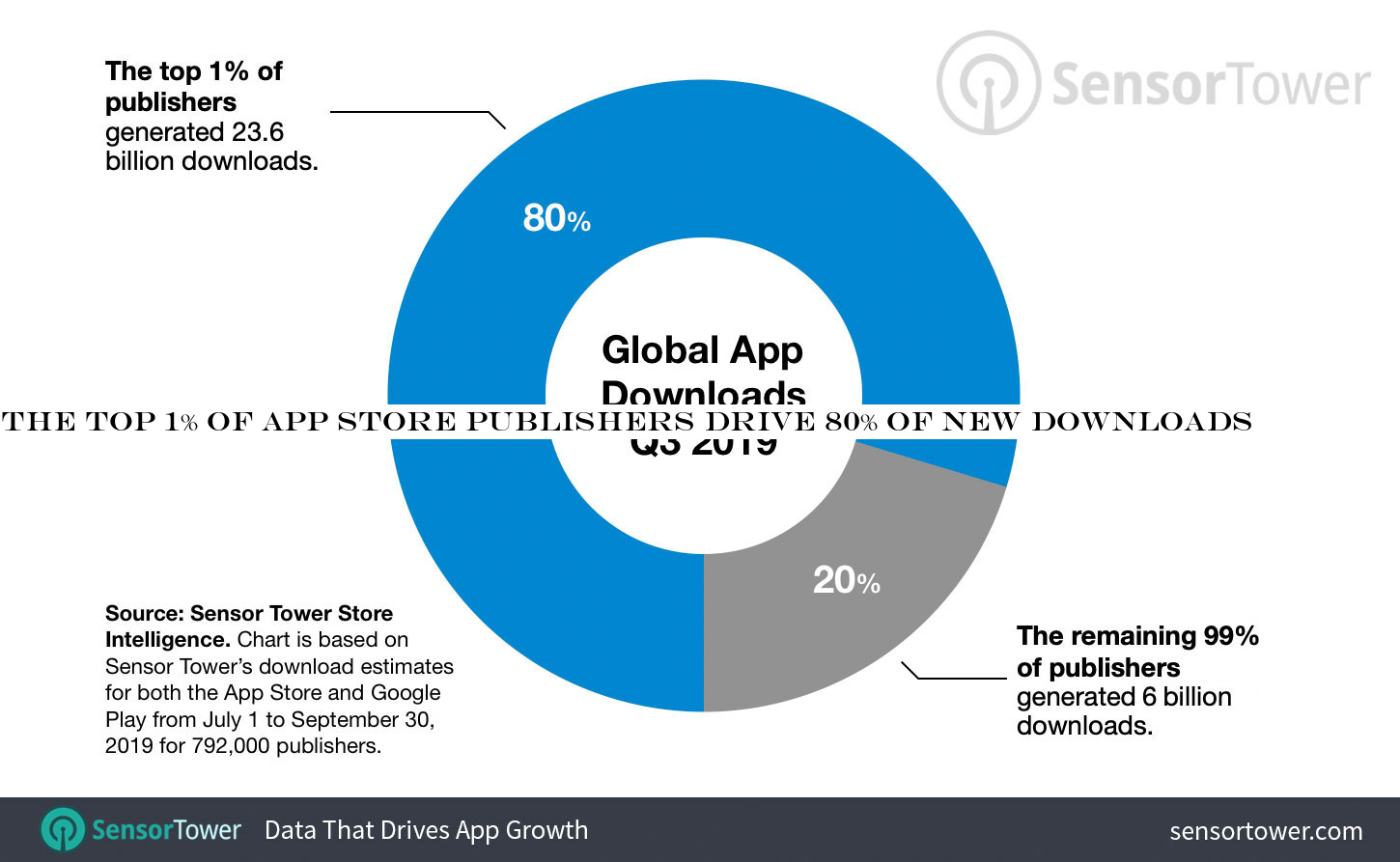
The data should not be all that surprising, given that larger, social platforms like Facebook and YouTube already serve audiences of over a billion. But it is concerning how uneven the market for new apps remains, especially considering that the number of available apps continues to expand, which makes the competition even more difficult.
The report notes there were more than 3.4 million apps available across the App Store and Google Play in 2018, up 65% from the 2.2 million apps available in 2014. But the number of apps that were able to achieve at least 1,000 installs has been declining over that same period — from 30% to 26%.
Focusing only on games, the top 1% of publishers — or 1,080 out of a total 108,000 publishers — saw 9.1 billion downloads out of the total 11.1 billion, or 82%. This averages out to more than 8.4 million installs each. The remaining 18% of downloads, or 2 billion, were shared among the remaining 106,920 publishers. That averages out to around 18,000 downloads each.

When apps were analyzed by revenue, the gap was wider. Just 1,526 publishers generated $20.5 billion out of the total $22 billion in revenue in the quarter. Meanwhile, the remaining $1.5 billion was split among 151,056 publishers, averaging out around $9,990 each.
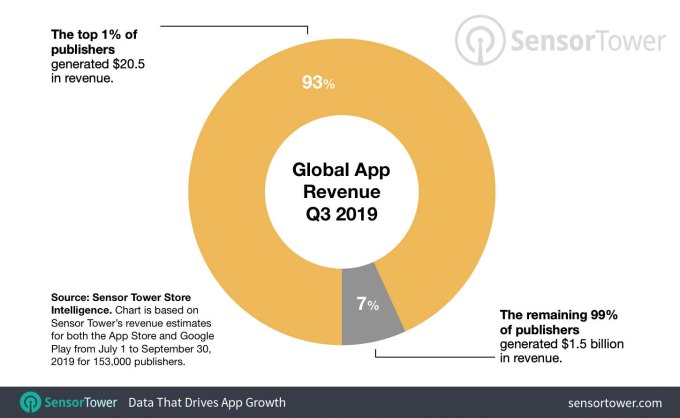
In terms of games revenue alone, the 445 publishers that make up the top 1% generated $15.5 billion in revenue, or 95% of all revenue, with the remaining $800 million split between the 44,029 publishers in the bottom 99%. This averages out to around $18,100 each.

None of these are new trends, Sensor Tower also notes. There hasn&t been much fluctuation in the top 1% share of installs or revenue for years. That means the majority of publishers will compete for a minority of new users and installs.
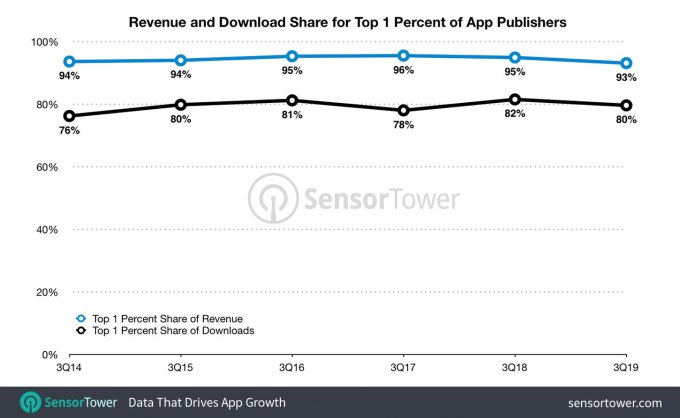
Image credits: Sensor Tower
- Details
- Category: Technology
Read more: The top 1% of app store publishers drive 80% of new downloads
Write comment (96 Comments)
GM CEO Mary Barra said Thursday that the automaker will bring its first electric truck to market in the fall of 2021.
The comments were made Thursday during GMinvestor day. Later this evening, Tesla, which also plans to start selling an electric truck in 2021, will reveal its &cybertruck& at an event in Hawthorne, Calif. Reuters first reported the GM news.
&General Motors understands truck buyers and… people who are new coming into the truck market,& Barra said during the investor conference, explaining the companyrationale for the move.
GMforay into electric trucks has been public before. Last month, the Detroit Free Press reported that GMDetroit-Hamtramck Assembly Plant would remain open to produce an electric pickup under a deal between the UAW and the automaker.
This is the first time the company has provided a timeline.
Several other companies are expected to bring electric trucks to the marketplace in the next several years, including newcomer Rivian, Tesla and Ford.
- Details
- Category: Technology
Read more: GM will bring an electric truck to market in 2021
Write comment (97 Comments)Page 293 of 5614

 14
14